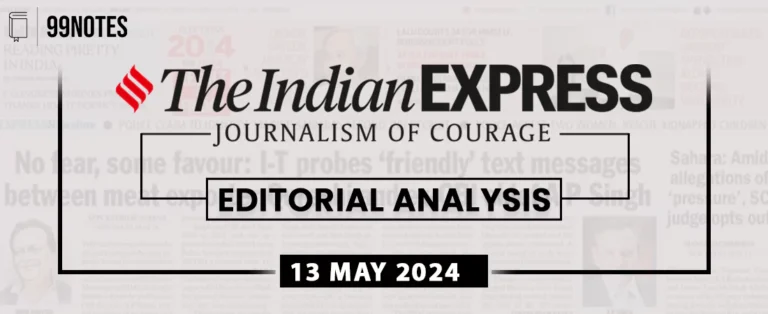6 July 2024 : Daily Current Affairs
1. Starmer new U.K. PM as Labour Party wins polls
(Source – The Hindu, International Edition – Page No. – 1)
| Topic: GS2 – International Relations |
| Context |
|
Analysis of the news:
- The U.K.’s Labour Party, led by Keir Starmer, won the July 4 general election by a landslide, securing 412 seats, a gain of 211.
- The Conservative Party, led by Prime Minister Rishi Sunak, fell to 121 seats, losing 250.
- Labour’s vote share was 35%, while the Conservatives secured 24%.
- The Liberal Democrats gained 63 seats, reaching a total of 71 seats.
- King Charles III appointed Keir Starmer as the U.K.’s 58th Prime Minister.
- Starmer, 61, emphasised change in his victory speech.
- Outgoing Prime Minister Sunak, who retained his Richmond seat, conceded defeat and took responsibility.
- Sunak, 44, acknowledged the peaceful transition of power and referenced his heritage.
| British Prime Minister Vs. Indian Prime Minister: |
|
| PYQ: Critically examine the procedures through which the Presidents of India and France are elected. (UPSC CSE (M) GS-2 2022) |
| Practice Question: Compare and contrast the constitutional positions of the British Prime Minister and the Indian Prime Minister in the context of their appointment, powers, and removal (150 Words /10 marks) |
2. At ₹1.27 lakh crore, defence production registered a new high in 2023-24, says Centre
(Source – The Hindu, International Edition – Page No. – 3)
| Topic: GS3 – Indian Economy – Changes in industrial policy and their effects on industrial growth. |
| Context |
| India’s defence production reached a record ₹1,26,887 crore in FY 2023-24, a 16.7% increase, driven by policy reforms and the “Make in India” initiative.Defence exports also hit a high of ₹21,083 crore, growing 32.5% over the previous year. |
Analysis of the news:
- India recorded its highest-ever growth in indigenous defence production in FY 2023-24, reaching ₹1,26,887 crore, a 16.7% increase from ₹1,08,684 crore in FY 2022-23.
- Defence Public Sector Undertakings (DPSUs), other PSUs, and private companies contributed to this growth.
- DPSUs and other PSUs accounted for 79.2% of the total value of production, while the private sector contributed 20.8%.
- The increase in defence production is attributed to government policy reforms, initiatives, and improved ease of doing business over the past decade.
- Defence Minister highlighted the success of the “Make in India” program and reaffirmed the government’s commitment to developing India as a leading global defence manufacturing hub.
- Defence exports also saw significant growth, reaching ₹21,083 crore in FY 2023-24, a 32.5% increase from ₹15,920 crore in the previous fiscal year.
- Over the past five years, the value of defence production in India has grown by over 60%, demonstrating a steady increase.
- The Ministry noted that the rise in defence exports has significantly contributed to the overall growth in indigenous defence production.
| PYQ: Foreign direct investment in the defence sector is now said to be liberalised. What influence is this expected to have on Indian defence and economy in the short and long run? (200 words/12.5m) (UPSC CSE (M) GS-3 2014) |
| Practice Question: Evaluate the impact of government policies on the growth of indigenous defence production in India.Discuss the factors contributing to the record growth in India’s indigenous defence production and exports in FY 2023-24. (250 Words /15 marks) |
3. Migrants face abuse and violence crossing Africa, says UN report
(Source – The Hindu, International Edition – Page No. – 13)
| Topic: GS2 – International Relations |
| Context |
|
Analysis of the news:
- A UN-backed report reveals severe risks faced by refugees and migrants crossing Africa towards the Mediterranean, often experiencing violence, abuse, and exploitation.
- Over the past decade, nearly 30,000 deaths or disappearances have been recorded in attempts to reach Europe via the Mediterranean.
- Crossing the Sahara Desert from January 2020 to May 2024 claimed 1,180 lives, averaging five deaths daily due to harsh conditions.
- Travellers encounter torture, kidnapping, human trafficking, sexual violence, robbery, detention, and forced expulsions.
- Despite these dangers, there has been an increase in attempts to cross these perilous land routes.
- The report emphasises the urgent need for enhanced protection measures along these routes to address the widespread abuses.
- Vincent Cochetel of UNHCR stressed the focus on finding protection solutions rather than facilitating movement, aiming to mitigate the suffering endured by refugees and migrants.
| Reasons for migration from Africa to the Mediterranean: |
|
| PYQ: How illegal transborder migration does pose a threat to India’s security? Discuss the strategies to curb this, bring out the factors which give impetus to such migration. (200 words/12.5m) (UPSC CSE (M) GS-3 2014) |
| Practice Question: Discuss the challenges faced by refugees and migrants crossing Africa to reach the Mediterranean, and suggest measures to enhance their protection (150 Words /10 marks) |
4. China’s Ambitious Rail Projects in Southeast Asia: Boosting Regional Connectivity Amid Challenges
(Source: Indian Express; Section: Explained; Page: 11)
| Topic: GS2 – International Relations |
| Context: |
|
Analysis of News:
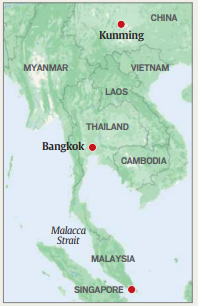
The East Coast Rail Link (ECRL): A Key Project
- The East Coast Rail Link (ECRL) is a significant infrastructure project in Malaysia, costing nearly $10 billion.
- It spans 665 km from Kota Bharu in the east to Port Klang on Malaysia’s west coast, strategically positioned along the Strait of Malacca.
- Initially facing funding constraints and political opposition due to its high cost, the project resumed in 2020 after renegotiations with China, aiming for completion by 2027.
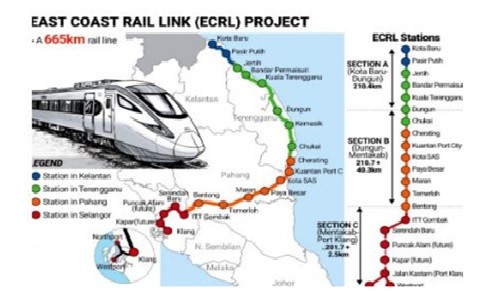
Pan-Asian Railway Network: Concept and Status
- China envisions a comprehensive “pan-Asian” railway network connecting Kunming to Singapore via multiple Southeast Asian countries.
- This ambitious plan includes western, central, and eastern lines through Myanmar, Thailand, Laos, Vietnam, Cambodia, and Malaysia.
- Currently, only the Laos-China section is operational, with challenges like varying railway track widths and economic viability casting doubts on its full realization.
Challenges and Economic Considerations
- Despite China’s efforts and financial backing, challenges such as high costs, technical difficulties, and logistical constraints have hindered progress.
- Critiques argue that alternative transport modes like maritime shipping remain more cost-effective and faster for both passengers and cargo, limiting the railway’s potential economic impact.
China’s Strategic Interests and Regional Dynamics
- China’s interest in the pan-Asian railway network predates the BRI, reflecting its long-term strategic goals in Southeast Asia.
- Economic ties with ASEAN nations have strengthened, with China becoming a major trading partner, despite concerns over debt sustainability and geopolitical tensions in the South China Sea.
- Beijing aims to build trust and goodwill through economic cooperation, rejecting accusations of “debt trap diplomacy” while promoting infrastructure development across historically underserved regions.
Conclusion:
- This analysis highlights China’s multifaceted approach in Southeast Asia, blending economic initiatives like the ECRL and the pan-Asian railway network with strategic geopolitical goals under the BRI framework.
| Practice Question: Discuss the significance of China’s Belt and Road Initiative (BRI) in Southeast Asia, with a focus on the East Coast Rail Link (ECRL) in Malaysia and the concept of a pan-Asian railway network. Analyze the challenges associated with these projects, and assess their implications for regional connectivity and China’s strategic interests in the region. (250 words/15 m) |
5. India Registers First Current Account Surplus in 11 Quarters, Reflecting Economic Resilience
(Source: Indian Express; Section: Explained; Page: 11)
| Topic: GS3 – Indian Economy |
| Context: |
| Last week, the Reserve Bank of India (RBI) revealed that India registered a current account surplus during the fourth quarter (Jan-Mar) of the 2023-24 financial year. This marks the first surplus in 11 quarters, signaling a noteworthy shift in the nation’s economic landscape. The current account is a critical indicator for policymakers as it influences the exchange rate of the rupee, India’s sovereign ratings, and provides insights into the overall health of the economy. |
Analysis of News:
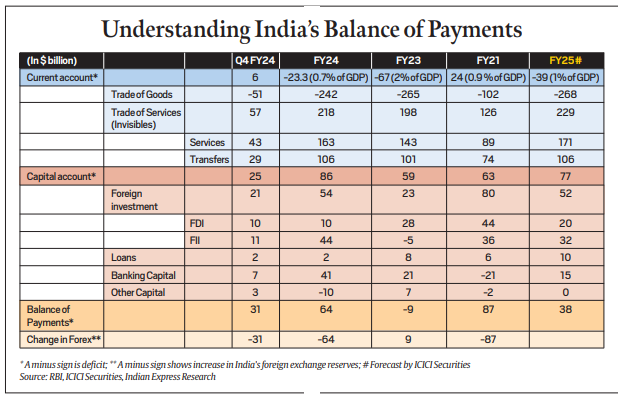
Understanding the Balance of Payments:
- The Balance of Payments (BoP) is a comprehensive ledger of a country’s transactions with the rest of the world.
- It tracks the flow of money into and out of the country, capturing how much money (in billions of US dollars) is received and spent. Positive entries indicate money coming into the country, while negative entries denote money going out.
- The BoP is crucial as it reflects the relative demand for the rupee against foreign currencies, influencing the exchange rate.
Constituents of the BoP:
Current Account:
- The current account records transactions of a ‘current’ nature and has two main subdivisions: trade of goods and trade of services.
- The trade or merchandise account covers the export and import of physical goods, determining the balance of trade.
- A trade deficit occurs when imports exceed exports, indicated by a negative sign. The second part, the ‘invisibles’ trade, includes services (banking, insurance, IT, tourism, transport), transfers (remittances), and income (investment earnings).
- In Q4, India had a surplus in the current account due to a surplus in invisibles, despite a trade deficit.
Capital Account
- The capital account deals with investments, such as Foreign Direct Investment (FDI) and Foreign Institutional Investments (FII).
- In Q4, there was a net surplus of $25 billion in the capital account.
- The BoP table balances through changes in foreign exchange reserves; a BoP surplus results in the RBI absorbing dollars to prevent the rupee from appreciating excessively, which would undermine export competitiveness.
Interpreting the Data
- The terms ‘deficit’ and ‘surplus’ do not necessarily equate to ‘bad’ and ‘good’. For instance, a current account deficit can be beneficial for a developing economy like India, which needs to import capital goods to build production capacity.
- A trade deficit can indicate strong domestic demand. Conversely, a surplus, like the one in FY2020-21 due to COVID-19 lockdowns, was undesirable as it reflected reduced economic activity.
- Experts suggest that a current account deficit of 1.5%-2% of GDP aligns with a healthy GDP growth rate of 7%-8%.
| Importance of Balance of Payment |
|
| PYQ: Craze for gold in Indians have led to a surge in import of gold in recent years and put pressure on balance of payments and external value of rupee. In view of this, examine the merits of Gold Monetization Scheme. (200 words/12.5m) (UPSC CSE (M) GS-3 2015) |
| Practice Question: Examine the significance of India registering a current account surplus in the fourth quarter of the 2023-24 financial year after 11 quarters of deficit. Discuss the components of the Balance of Payments (BoP) and analyze how changes in these components can impact the overall economic health and exchange rate of the country. (250 words/15 m) |
6. Rahul Gandhi Alleges Government Neglect in Compensation for Fallen Agniveer; Army Clarifies Rs 1.65 Crore Payment
(Source: Indian Express; Section: Explained; Page: 11)
| Topic: GS2 – Governance – Government policies – Issues arising out of their design & implementation. |
| Context: |
|
Analysis of News:
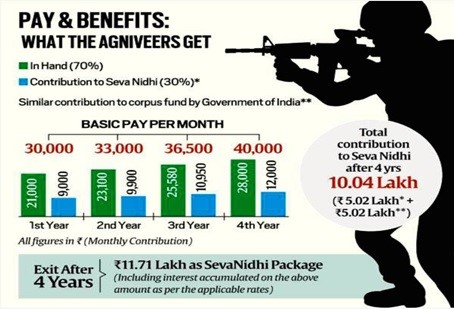
What is the Agnipath Scheme?
- It allows patriotic and motivated youth to serve in the Armed Forces for a period of four years. The youth joining the army will be called Agniveer.
- Under the new scheme, around 45,000 to 50,000 soldiers will be recruited annually, and most will leave the service in just four years.
- However, after four years, only 25% of the batch will be recruited back into their respective services, for a period of 15 years.

Eligibility Criteria:
- It is only for personnel below officer ranks (those who do not join the forces as commissioned officers).
- Commissioned officers hold an exclusive rank in the Indian armed forces. They often hold a commission under the president’s sovereign power and are officially instructed to protect the country.
- Aspirants between the ages of 17.5 years and 23 years are eligible to apply.
Objectives:
- It is expected to bring down the average age profile of the Indian Armed Forces by about 4 to 5 years.
- The scheme envisions that the average age in the forces is 32 years today, which will go down to 26 in six to seven years.
Army’s Response and Breakdown of Compensation
- On July 3, the Army issued a statement confirming that the Agniveer’s family would receive Rs 1.65 crore in compensation.
- Government sources clarified that this amount includes Rs 48 lakh from the Centre, Rs 50 lakh as insurance from financial institutions under a Memorandum of Understanding (MoU), an additional sum of Rs 39,000, Rs 44 lakh as ex-gratia, Rs 8 lakh from the Army welfare fund, Rs 13 lakh as balance of pay until completion of tenure, and Rs 2.3 lakh as Seva Nidhi.
- The Army noted that Rs 98.39 lakh had already been paid to the fallen Agniveer’s family.
Insurance and Ex-Gratia for Soldiers
Insurance
- Regular soldiers contribute Rs 5,000 per month towards the Army Group Insurance Fund, insuring them for Rs 50 lakh.
- Agniveers are insured for Rs 48 lakh without contributing from their salary. This sum is paid to all fallen soldiers regardless of the cause of death.
- The services have also signed MoUs with banks where defence personnel’s salaries, including Agniveers’, are credited, and the personnel are insured by the banks as per their policies.
Ex-Gratia
- Agniveers who die in service receive Rs 44 lakh as ex-gratia if their death is attributable to or aggravated by military service.
- For regular soldiers, the ex-gratia can be Rs 25 lakh, Rs 35 lakh, or Rs 45 lakh, depending on the nature of the casualty.
- State governments also provide ex-gratia, ranging from zero to Rs 1 crore, applicable to both Agniveers and regular soldiers.
Seva Nidhi for Agniveers
- Seva Nidhi is a contributory scheme exclusive to Agniveers. If an Agniveer’s death is neither attributable to nor aggravated by military service, the accumulated amount till the date of death, including the government’s contribution and interest, is paid.
- For deaths in service or operations, the full pay for the unserved period up to four years, including the Seva Nidhi component, is provided.
Benefits Exclusive to Regular Soldiers
Regular soldiers’ families receive significant benefits such as gratuity and monthly family pensions. These include:
- Death gratuity of 15 days’ pay for each completed year of service, up to a maximum of Rs 25 lakh.
- Ordinary family pension of 50% of the last pay drawn for up to 10 years, and 30% thereafter for deaths not attributable to military service.
- Special family pension of 60% of the last pay for deaths attributable to military service.
- Liberalised family pension of 100% of the last pay for deaths in operations, tax-free.
- Children’s education allowance covering school/college fees, books, transportation, hostel, and uniforms for operational deaths.
- Educational scholarships for children and wives of soldiers who died due to non-operational reasons.
- Access to the Ex-Servicemen Contributory Health Scheme (ECHS) for medical care.
| What are the Various Concerns Being Raised Regarding the Agnipath Scheme? |
|
In order to seamlessly incorporate the Agniveers into the milieu of military units, it is important that the respective unit commanders are clear about the challenges ahead. These challenges are beyond the individual capacities of the Agniveers, in which they are likely to excel for the sake of being retained. The challenges are more intangible in nature and warrant the attention of the leaders. Adverse Effect on Professional Capabilities:
Degradation of Operational Capability:
What is teeth-to-tail ratio (T3R)?
|
| PYQ: Border management is a complex task due to difficult terrain and hostile relations with some countries. Elucidate the challenges and strategies for effective border management. (200 words/12.5m) (UPSC CSE (M) GS-3 2016) |
| Practice Question: Discuss the allegations regarding the government’s handling of compensation for fallen Agniveers and the subsequent clarifications provided by the Army. Analyze the implications of this issue on government accountability, welfare of defense personnel, and public perception. (250 words/15 m) |
Prelims Facts
1. Central Travancore a sitting duck for avian flu
(Source – The Hindu, International Edition – Page No. – 9)
| Context |
|
Avian Influenza (H5N1):
- Virus Type: Avian Influenza (H5N1) is a type of influenza virus that primarily infects birds, particularly poultry.
- Transmission: It spreads through direct contact with infected birds or their droppings, and sometimes through contaminated surfaces.
- Human Infections: H5N1 can infect humans who come into close contact with infected birds, leading to severe respiratory illness.
- Symptoms: In humans, symptoms include fever, cough, sore throat, abdominal pain, and respiratory distress. Severe cases can result in pneumonia and acute respiratory distress syndrome (ARDS).
- Prevention: Control measures include culling infected birds, strict biosecurity measures in poultry farms, and public health education to minimise human exposure.
- Global Concern: H5N1 is a concern due to its potential to mutate into a form that spreads easily among humans, potentially causing a pandemic.
- Kerala Breakout: In Kerala, an outbreak of Avian Influenza (H5N1) has expanded beyond poultry to infect crows, kites, pigeons, and herons. This development raises concerns about economic losses and human transmission, marking a significant shift from previous poultry-centric outbreaks.
2. Women get only 7% MSME credit: RBI ED
(Source – The Hindu, International Edition – Page No. – 11)
| Context |
| Neeraj Nigam, RBI Executive Director, highlighted challenges of low female labour force participation and limited credit access for women-led MSMEs, underscoring barriers to economic growth and financial inclusion in India. |
Analysis of the news:
- Neeraj Nigam, Executive Director at RBI, highlighted low female labour force participation as hindering economic growth and financial inclusion.
- Female labour force participation in FY22 was 32.8%, significantly lower than men’s at over 77%.
- Women lead 20% of MSMEs, yet they receive only 7% of outstanding credit allocated to the sector.
- Nigam emphasised the need to increase credit supply to women-led businesses to enhance their economic participation and development.
- His remarks were made at the ‘Financing Women Collaborative’ event organised by Niti Aayog and Transunion Cibil.
3. 2 Gaganyaan astronauts to go to ISS aboard the Axiom-4 mission
(Source: Indian Express; Section: Express Network; Page: 08)
| Context: |
|
Analysis of News:
About Axiom-4 Mission
- The Axiom-4 mission, the fourth private astronaut mission of NASA and Axiom Space, will transport the Indian astronauts to the ISS.
- This mission is expected to dock with the ISS for fourteen days. According to NASA, the Ax-4 crew members will train with NASA, international partners, and SpaceX to prepare for their flight.
- Axiom Space has contracted SpaceX as the launch provider for transportation to and from the space station, ensuring the astronauts are familiar with the Dragon spacecraft’s systems, procedures, and emergency preparedness.
Collaborative Efforts
India-US Collaboration
- The collaboration between ISRO and NASA has been in progress for some time.
- A joint statement during Prime Minister Narendra Modi’s visit to the US last year indicated that NASA would provide advanced training to Indian astronauts.
- Later, NASA administrator Bill Nelson confirmed during his visit to Delhi that NASA would train an Indian astronaut for a mission to the ISS by the end of 2024.
- This partnership signifies the strengthening of space exploration ties between India and the US.
Future Prospects: India’s Human Spaceflight Program
Timeline and Milestones
- India’s own human spaceflight mission, Gaganyaan, is unlikely to take place before 2025.
- The first unmanned flight is still pending, and the inaugural manned flight will only be launched after two successful unmanned flights.
- This cautious approach underscores the emphasis on safety and reliability in India’s human spaceflight program.
| About the International Space Station |
|
4. Earth Reaches Aphelion: Understanding the Impact of Earth’s Elliptical Orbit
(Source: Indian Express; Section: Explained; Page: 11)
| Context: |
| Every July, Earth reaches its aphelion, the point in its orbit where it is farthest from the Sun. This year, it occurred on a Friday (5th July,2024). The elliptical nature of Earth’s orbit, rather than a perfect circle, causes this phenomenon. |
Analysis of News:
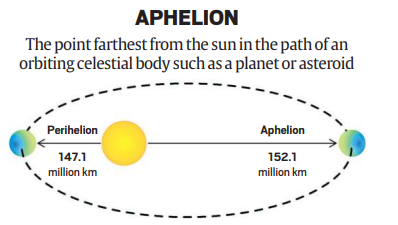
Elliptical Orbits and Gravitational Influences
The Shape of Orbits
- According to Experts, all planets in the solar system travel in elongated circles around the Sun due to gravitational interactions.
- These interactions likely occur in other star systems as well. The gravitational pull from other planets, particularly the massive Jupiter, distorts these orbits into ellipses.
Measuring Eccentricity
- The deviation of an orbit from a perfect circle is measured by its eccentricity. Higher eccentricity indicates a more elliptical orbit.
- For instance, Mars has an eccentricity of 0.094, and Pluto has 0.244, while Earth has a relatively low eccentricity of 0.017.
Earth’s Distance from the Sun at Aphelion and Perihelion
Aphelion Distance
- At aphelion, Earth’s distance from the Sun is about 152.1 million kilometers. In contrast, six months later, during perihelion in early January, Earth is approximately 147.1 million kilometers from the Sun.
Impact of Aphelion on Earth’s Temperatures
Misconceptions about Seasons
- A common misconception is that Earth’s varying distance from the Sun causes the seasons.
- While we receive 7% less sunlight at aphelion than at perihelion, leading to slightly milder summers and winters in the Northern Hemisphere, this effect is counterbalanced by Earth’s axial tilt.
- The tilt causes the hemispheres to slant towards or away from the Sun at different points in the orbit, driving seasonal changes.
Hypothetical Scenarios: Perfect and Eccentric Orbits
Perfect Circular Orbit
- If Earth’s orbit were a perfect circle, the lengths of the seasons would be equal. Currently, spring and summer are slightly longer than fall and winter in the Northern Hemisphere.
- However, a perfectly circular orbit would not significantly alter other aspects of Earth’s climate or environment.
Increased Orbital Eccentricity
- If Earth’s orbit became more eccentric, the consequences could be severe.
- The Southern Hemisphere would experience extreme seasonal variations, with unbearably hot summers and intolerably cold winters, leading to potential crop failures and harsh living conditions.
- Such extreme conditions would hinder the development and sustainability of advanced civilizations.



